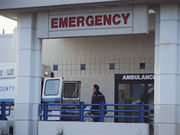Patients with ER deaths were older, more likely to be male and white, had more severe triage acuity scores
THURSDAY, July 7, 2016 (HealthDay News) — From 1997 to 2011 there was a 48 percent reduction in emergency department (ED) mortality rates, according to a study published online July 6 in Health Affairs.
Hemal K. Kanzaria, M.D., from the University of California, San Francisco, and colleagues described national trends in U.S. ED mortality and visit rates. ED visit data for adults aged 18 years and older were analyzed from the National Hospital Ambulatory Medical Care Survey from 1997 to 2011. Data were included for 367,618 observations, representing 1.3 billion ED visits.
The researchers found that patients with ED death were older, were more likely to be male and white, and had more severe triage acuity scores compared with those who survived to ED discharge or hospital admission. The proportion of patients who visited an ED in the South or a rural ED was higher in patients who died than in those who survived. From 1997 to 2011 there was a reduction in ED mortality rates from 1.48 to 0.77 per 1,000 (48 percent reduction).
“The etiology behind the nearly 50 percent reduction in ED mortality is likely multifactorial,” the authors write. “Describing changes in ED mortality can help improve understanding of the impact that recent advances in palliative, prehospital, and emergency critical care have had on the locus of death in the United States.”
Copyright © 2016 HealthDay. All rights reserved.








